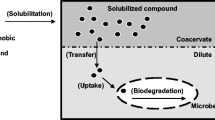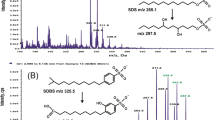Abstract
A recent work has shown that hydrophobic organic compounds solubilized in the micelle phase of some nonionic surfactants present substrate toxicity to microorganisms with increasing bioavailability. However, in cloud point systems, biotoxicity is prevented, because the compounds are solubilized into a coacervate phase, thereby leaving a fraction of compounds with cells in a dilute phase. This study extends the understanding of the relationship between substrate toxicity and bioavailability of hydrophobic organic compounds solubilized in nonionic surfactant micelle phase and cloud point system. Biotoxicity experiments were conducted with naphthalene and phenanthrene in the presence of mixed nonionic surfactants Brij30 and TMN-3, which formed a micelle phase or cloud point system at different concentrations. Saccharomyces cerevisiae, unable to degrade these compounds, was used for the biotoxicity experiments. Glucose in the cloud point system was consumed faster than in the nonionic surfactant micelle phase, indicating that the solubilized compounds had increased toxicity to cells in the nonionic surfactant micelle phase. The results were verified by subsequent biodegradation experiments. The compounds were degraded faster by PAH-degrading bacterium in the cloud point system than in the micelle phase. All these results showed that biotoxicity of the hydrophobic organic compounds increases with bioavailability in the surfactant micelle phase but remains at a low level in the cloud point system. These results provide a guideline for the application of cloud point systems as novel media for microbial transformation or biodegradation.





Similar content being viewed by others
References
Adrion AC, Nakamura J, Shea D, Aitken MD (2016) Screening nonionic surfactants for enhanced Biodegradation of polycyclic aromatic hydrocarbons remaining in soil after conventional biological treatment. Environ Sci Technol 50(7):3838–3845
Aryal M, Liakopoulou-Kyriakides M (2013) Biodegradation and kinetics of Phenanthrene and pyrene in the presence of nonionic surfactants by Arthrobacter strain Sphe3. Water Air Soil Poll 224(2)
Castro-Silva C, Ruiz-Valdiviezo VM, Rivas-Rivera SG, Sosa-Trinidad AR, Luna-Guido M, Delgado-Balbuena L, Marsch R, Dendooven L (2015) Bioavailability and dissipation of anthracene from soil with different alkalinity and salinity. J Environ Biol 36(1):229–234
Dai Z, Wang Z, Xu JH, Qi H (2010) Assessing bioavailability of the solubilization of organic compound in nonionic surfactant micelles by dose-response analysis. Appl Microbiol Biot 88(1):327–339
Ghosh I, Mukherji S (2016) Diverse effect of surfactants on pyrene biodegradation by a Pseudomonas strain utilizing pyrene by cell surface hydrophobicity induction. Int Biodeter Biodegr 108:67–75
Hinze WL, Pramauro E (1993) A critical-review of surfactant-mediated phase separations (cloud-point extractions) - theory and applications. Crit Rev Anal Chem 24(2):133–177
Huang X, Tian Y, Luo YR, Liu HJ, Zheng W, Zheng TL (2008) Modified sublimation to isolate phenanthrene-degrading bacteria of the genera Sphingomonas and Burkholderia from Xiamen oil port. Mar Pollut Bull 57(6–12):538–543
Isken S, Heipieper HJ (2003) Encyclopedia of environmental microbiology. (ed) toxicity of organic solvents to microorganisms. John Wiley & Sons, Inc
Laane C, Boeren S, Vos K, Veeger C (1987) Rules for optimization of biocatalysis in organic solvents. Biotechnol Bioeng 30(1):81–87
Liu S, Guo C, Liang X, Wu F, Dang Z (2016) Nonionic surfactants induced changes in cell characteristics and phenanthrene degradation ability of Sphingomonas sp. GY2B. Ecotox Environ Safe 129:210–218
Mesbaiah FZ, Mansour F, Eddouaouda K, Badis A (2016) Surfactant effects on biodegradation of polycyclic aromatic hydrocarbons. Desalin Water Treat 57(13):5995–6000
Mulligan CN, Yong RN, Gibbs BF (2001) Surfactant-enhanced remediation of contaminated soil: a review. Eng Geol 60(1–4):371–380
Pan T, Ren S, Xu M, Sun G, Guo J (2013) Extractive biodecolorization of triphenylmethane dyes in cloud point system by Aeromonas hydrophila DN322p. Appl Microbiol Biotechnol 97(13):6051–6055
Pan T, Deng T, Zeng X, Dong W, Yu S (2016a) Extractive biodegradation and bioavailability assessment of phenanthrene in the cloud point system by Sphingomonas polyaromaticivorans. Appl Microbiol Biot 100(1):431–437
Pan T, Deng T, Zeng X, Dong W, Yu S (2016b) Extractive biodegradation and bioavailability assessment of phenanthrene in the cloud point system by Sphingomonas polyaromaticivorans. Appl Microbiol Biotechnol 100(1):431–437
Patel U, Dharaiya N, Bahadur P (2016) Preservative solubilization induces microstructural change of triton X-100 micelles. J Mol Liq 216:156–163
Quina FH, Hinze WL (1999) Surfactant-mediated cloud point extractions: an environmentally benign alternative separation approach. Ind Eng Chem Res 38(11):4150–4168
Sakulwongyai S, Trakultamupatam P, Scamehorn JF, Osuwan S, Christian SD (2000) Use of a surfactant coacervate phase to extract chlorinated aliphatic compounds from water: extraction of chlorinated ethanes and quantitative comparison to solubilization in micelles. Langmuir 16(22):8226–8230
Semple KT, Doick KJ, Jones KC, Burauel P, Craven A, Harms H (2004) Defining bioavailability and bioaccessibility of contaminated soil and sediment is complicated. Environ Sci Technol 38(12):228A–231A
Shi Z, Chen J, Liu J, Wang N, Sun Z, Wang X (2015) Anionic-nonionic mixed-surfactant-enhanced remediation of PAH-contaminated soil. Environ Sci Pollut R 22(16):12769–12774
Song M, Bielefeldt AR (2012) Toxicity and inhibition of bacterial growth by series of alkylphenol polyethoxylate nonionic surfactants. J Hazard Mater 219:127–132
Wang Z (2010) Non-ionic surfactants. In: Wendt PL, Hoysted DS (eds) Extractive whole cell biotransformation in cloud point system. Nova Science Publishers, New York, pp 83–136
Wang Z, Dai Z (2010) Extractive microbial fermentation in cloud point system. Enzym Microb Technol 46(6):407–418
Wang Z, Xu JH, Chen D (2008) Whole cell microbial transformation in cloud point system. J Ind Microbiol Biotechnol 35(7):645–656
Yang XJ, Lu GN, Wang R, Xie YY, Guo CL, Yi XY, Dang Z (2015) Competitive solubilization of 4,4 '-dibromodiphenyl ether, naphthalene, and pyrene mixtures in triton X series surfactant micelles: the effect of hydrophilic chains. Chem Eng J 274:84–93
Zhang D, Zhu L, Li F (2013) Influences and mechanisms of surfactants on pyrene biodegradation based on interactions of surfactant with a Klebsiella oxytoca strain. Bioresour Technol 142:454–461
Acknowledgements
The authors acknowledge the financial support from the National Natural Science Foundation of China (21407070), Natural Science Foundation of Jiangxi Province (20151BAB213019), State Key Laboratory of Applied Microbiology Southern China (sklam002-2015), and PhD Start-up Fund of Jxust (jxxjbs13018), Natural Science Foundation of Jxust (NSFJ2014-G02).
Author information
Authors and Affiliations
Corresponding author
Ethics declarations
Conflict of interest
The authors declare that they have no conflict of interest.
Ethical approval
This article does not contain any studies with human participants or animals performed by any of the authors.
Additional information
Responsible editor: Philippe Garrigues
Rights and permissions
About this article
Cite this article
Pan, T., Liu, C., Zeng, X. et al. Biotoxicity and bioavailability of hydrophobic organic compounds solubilized in nonionic surfactant micelle phase and cloud point system. Environ Sci Pollut Res 24, 14795–14801 (2017). https://doi.org/10.1007/s11356-017-9076-4
Received:
Accepted:
Published:
Issue Date:
DOI: https://doi.org/10.1007/s11356-017-9076-4




